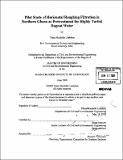| dc.contributor.advisor | Susan Murcott. | en_US |
| dc.contributor.author | Losleben, Tamar | en_US |
| dc.contributor.other | Massachusetts Institute of Technology. Dept. of Civil and Environmental Engineering. | en_US |
| dc.coverage.spatial | f-gh--- | en_US |
| dc.date.accessioned | 2008-12-11T18:45:13Z | |
| dc.date.available | 2008-12-11T18:45:13Z | |
| dc.date.copyright | 2008 | en_US |
| dc.date.issued | 2008 | en_US |
| dc.identifier.uri | http://hdl.handle.net/1721.1/43883 | |
| dc.description | Thesis (M. Eng.)--Massachusetts Institute of Technology, Dept. of Civil and Environmental Engineering, 2008. | en_US |
| dc.description | Includes bibliographical references (p. 123-126). | en_US |
| dc.description.abstract | In Northern Region Ghana (NRG), highly turbid rainwater runoff and intermittent streams are collected in earthen dams called dugouts. These dams serve as many communities' main source of drinking and domestic water despite their physical and microbial contamination. Slow sand filtration (SSF), a low-cost technology for treating microbial contaminated drinking water is only recommended for water < 50 NTU. Two research objectives were established to address this issue; to characterize dugout particle sizes and distribution and to test a pilot horizontal roughing filter's (HRF) effectiveness at removing turbidity from highly turbid dugout water. Among the four dugouts tested in NRG, they typically have high concentrations of non-setttleable colloidal (< 1 m) and small supracolloidal particles (< 10 m). In addition, a pilot HRF at Ghanasco Dam in Tamale, NRG was conducted using three 7m tubes filled with three sizes of granite gravel, local gravel, and broken pieces of ceramic filters arranged by decreasing size. The pilot study was run for 52 days to test if HRF could reduce the high turbidity (305 NTU) to < 50 NTU to make SSF a viable option. There were a number of promising outcomes: the best performing media, the granite gravel, by removing an average 46% of the influent turbidity (filter coefficient X = 0.002 min-1), produced an average effluent turbidity of 51 NTU which almost achieved the goal of < 50 NTU. The granite gravel HRF removed twice as much turbidity (46%) as plain settling (25%). Overall, the granite gravel removed 76% and 84% of the influent turbidity according to the settling test and pilot HRF data respectively. Three recommendations derived from this pilot HRF study are (1) to monitor dugout water quality, (2) to investigate media and particle properties to enhance colloidal particle removal | en_US |
| dc.description.abstract | (cont.) (3) to modify the HRF to effectively remove very high dry season turbidities and likely even higher rainy-season turbidities from dugout water. | en_US |
| dc.description.statementofresponsibility | by Tamar Rachelle Losleben. | en_US |
| dc.format.extent | 149 p. | en_US |
| dc.language.iso | eng | en_US |
| dc.publisher | Massachusetts Institute of Technology | en_US |
| dc.rights | M.I.T. theses are protected by
copyright. They may be viewed from this source for any purpose, but
reproduction or distribution in any format is prohibited without written
permission. See provided URL for inquiries about permission. | en_US |
| dc.rights.uri | http://dspace.mit.edu/handle/1721.1/7582 | en_US |
| dc.subject | Civil and Environmental Engineering. | en_US |
| dc.title | Pilot study of horizontal roughing filtration in northern Ghana as pretreatment for highly turbid dugout water | en_US |
| dc.type | Thesis | en_US |
| dc.description.degree | M.Eng. | en_US |
| dc.contributor.department | Massachusetts Institute of Technology. Department of Civil and Environmental Engineering | |
| dc.identifier.oclc | 263684565 | en_US |
